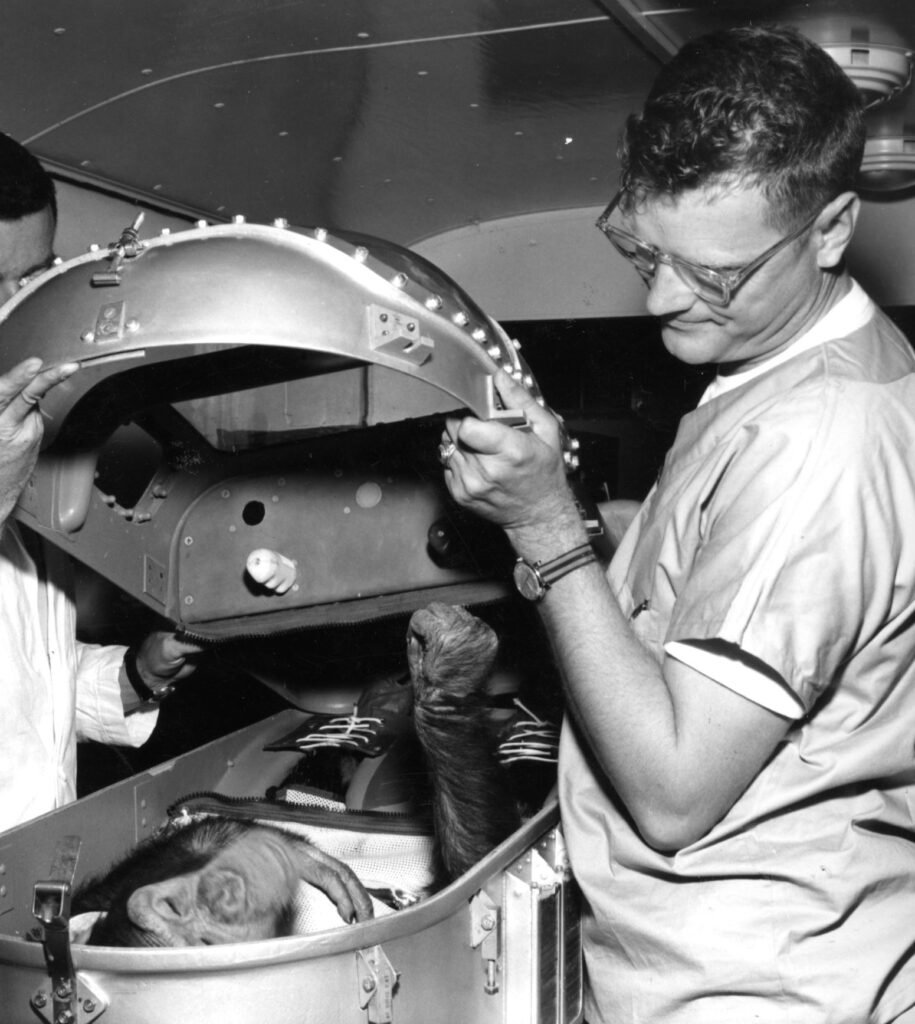Edward C. Dittmer Sr. was born in Laverne, Minnesota in 1918. After serving in the U.S. Army during World War II, Dittmer enlisted in the Army Air Corps in 1946. In 1956 he was assigned to Holloman Air Force Base in Alamogordo, New Mexico, where he became an important member of the space biology projects. Recognizing Dittmer’s talent and enthusiasm, Colonel John Stapp had Dittmer named the Non-Commissioned Officer in Command (NCOIC) of the Holloman Aeromedical Field Laboratory’s Space Biology Branch.
During the Manhigh project (1955-1958), Sergeant Dittmer played a vital role, preparing balloon pilots for ascents up to twenty miles above the Earth in order to determine man’s capacity to function at such high altitudes. During one Manhigh practice flight, only Dittmer’s medical skill and quick reaction saved the balloon pilot’s life after his gondola crash-landed.
Mr. Dittmer’s next assignment was as the NCOIC responsible for training six “astro-chimps” to be sent into space prior to human astronauts as part of Project Mercury. Sergeant Dittmer spent eighteen months at the Holloman Aeromedical facility, training the chimpanzees in simple tasks such as pulling levers in response to light signals. If the chimps were successful it would be evidence that humans too could operate equipment in the Mercury capsule during liftoff, weightlessness, and reentry. Ultimately, two chimpanzees were sent into space, HAM (an acronym for Holloman Aeromedical) and Enos.
HAM was launched on a suborbital flight from Cape Canaveral, Florida on January 31, 1961. He performed his required tasks with great accuracy during the sixteen and a half-minute, 363 nautical mile mission, which was monitored by onboard cameras. Although his Mercury capsule landed 60 miles off course, it was retrieved safely. HAM was rewarded with an apple and joyfully “greeted” everyone aboard the rescue vessel. With this successful test of the Mercury capsule, and no signs of injury to HAM by his exposure to weightlessness, the sub-orbital flights of Alan Shepard and Gus Grissom soon followed.
Prior to sending astronauts on orbital missions, a second astrochimp mission was launched. On December 21, 1961, Enos, described as “meditative” and a “hard worker” and probably the most intelligent of the chimps Dittmer had trained, was launched on a much more ambitious mission. Enos flew up to 17,500 miles per hour on a flight lasting three hours and twenty-two minutes, and orbited the Earth twice, a distance of 50,000 miles. Dittmer was present at the launch from Cape Canaveral, and aboard the retrieval ship. When the capsule was opened, Enos ran out and jumped into Dittmer’s arms. Remarkably, Enos had continued to perform his mission even though an electrical malfunction halfway through the flight resulted in him being shocked 79 times for performing his tasks correctly. Two months after Enos’ flight John Glenn became the first American to orbit the Earth.
In 1963, Master Sergeant Ed Dittmer was transferred to the Military Advisory Group in Saigon, South Vietnam, where he flew on many pilot rescue missions. In 1973 he retired as a Senior Master Sergeant with 30 years of distinguished service.
Later Edward Dittmer spoke of HAM; ” . . . I think . . . I know he liked me. I’d hold him and he was just like a little kid. He’d put his arm around me and he’d play, you know. He was a well-tempered chimp.” A few days after his flight, NASA personnel tried to get HAM back into his flight couch for press photos, but he refused to go near it. As Primatologist Jane Goodall said in an interview for the 2003 film One Small Step: The Story of the ‘Space Chimps’, “Actually, that is the most extreme fear that I’ve ever seen on any chimpanzee.”
HAM lived a long and healthy life and suffered no ill effects from his journey, dieing of liver failure at the age of 26. Unfortunately, Enos developed a drug-resistant strain of shigellosis and succumbed to dysentery on November 4, 1962. NASA said his death was not caused by his space flight.
Ed Dittmer quote:
“No one ever held Enos. If you had him he was on a little strap. Enos was a good chimp, he was smart, but he didn’t take to people, very little. They said he was a mean chimp, but he wasn’t really mean. He just didn’t take to cuddling.”

